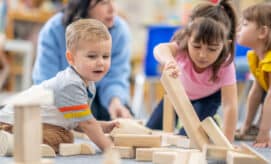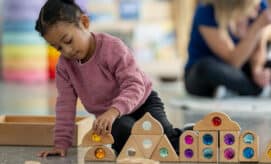The ability to recognize, approach, and solve problems is foundational to success in all areas of life, during childhood and beyond. These problem-solving skills emerge at an early age, and are nurtured and reinforced through playful learning activities and positive interactions between young children and their adult caregivers. In this article, we explore the role of problem-solving in early childhood, and offer suggestions and strategies for supporting and encouraging the children in our care as they develop these important foundational skills.
What Are Problem-solving Skills?
Problem-solving skills equip us to respond to challenges and difficult situations by thinking about possible solutions and then creating an action plan for testing those solutions. Solving problems requires us to tap into a variety of different skills at once, including:
- Creativity: being able to come up with unique solutions to problems by generating a variety of ideas and possibilities
- Analytical thinking: breaking down a problem into manageable parts
- Decision-making: considering various options and ways of solving the problem and deciding on the most logical solution
- Initiative: an ability to take action towards finding a solution when there is a problem to be solved
- Persistence: commitment to finding a solution through a willingness to try again when an initial attempt fails
Why Do Problem-solving Skills Matter for Young Children?
Knowing how to solve problems is important, because no matter what our age, challenging situations are part of our daily lives!
For very young children, frustrations and challenges might include: figuring out how to use a particular toy, looking for something that is misplaced or located in a difficult-to-access spot, or deciding what to do when a tower they’re building with blocks falls over or when they want to play with a toy that another child is using. As children get older, their challenges become more complex, showing up in areas such as school, activities outside of school, and relationships.
By introducing the little ones in our care to problem-solving skills while they are young, we help them gain confidence in their ability to come up with creative solutions of their own when they encounter challenges. When a child is frustrated, we can ask the child to describe the problem they are facing and encourage them to offer ideas for resolving the situation. These types of conversations give children opportunities to practice foundational problem-solving skills and to gain a sense of trust in their ability to navigate the challenges that come their way during play, school, and throughout life.
How Problem-Solving Skills Develop: Ages 0-3
Infants and toddlers spend a good part of their days observing, exploring, and trying to overcome obstacles. This early problem-solving behavior emerges early and develops with practice. Below is a framework from Illinois Early Learning Project that describes key problem-solving behaviors, milestones, and achievements that occur in children between the ages of 0 and 3.
Birth to 9 months
At this age, children are building the foundation for problem solving through active exploration and social interaction. You might observe them attempting to get a caregiver’s attention when they need something by using sounds, cries, gestures, and facial expressions.
To support the development of problem-solving skills at this age, educators and care providers can respond with thoughtfulness and intention when infants attempt to get their attention. They can also interact with them using frequent back-and-forth exchanges throughout the day to provide opportunities for them to reinforce their skills.
7 months to 18 months
As children approach toddlerhood, they begin to develop more physical strength that allows them to manipulate their environment. They discover that they can solve problems on their own and that they can rely on their caregivers when they need support. At this age, you might observe children repeating an action over and over again to figure out how an object works. You might also see them experimenting with different strategies to accomplish a goal, such as pulling the string of a toy train to move it closer or crawling to get a ball that has rolled away.
To support little ones at this stage in strengthening their problem solving skills, by encouraging their independence to try new things and praising them for accomplishing new tasks on their own.
16 months to 24 months
As children approach their second birthday, they have an enhanced capacity to solve problems independently. You may observe them utilizing trial and error to figure out a problem, such as trying to insert a shape at different angles to make it fit in a sorter. You will likely also see children verbally communicating their needs with caregivers and utilizing objects in the environment to solve problems, such as using a bucket to move numerous books to the other side of the room.
At this age, care providers and educators can support children in practicing problem-solving skills by talking through various solutions with the child, such as “I wonder what would happen if we turned the puzzle piece this way.” It can also be beneficial to give children opportunities to solve problems without your help by stepping back and encouraging them to try on their own before you jump in to support.
21 months to 36 months
Preschoolers are able to handle more complex thoughts, such as strategizing solutions and making a decision about the best option to solve a problem, with fewer trials. At this age, children increasingly become more autonomous and will attempt to overcome obstacles on their own or with limited support from their caregiver. You might also observe them showing pride when accomplishing tasks and using more refined skills to solve problems, such as using a napkin to clean up a spill without asking an adult for help.
To support preschoolers in strengthening their skills, educators can follow the child’s lead and pay attention to their cues when assisting in a task and provide the child with uninterrupted time to work on activities independently.
Creating an Early Learning Curriculum that Encourages Problem-Solving
Many of the playful activities that children enjoy in our care & learning programs encourage the development of foundational problem-solving skills. Some great ones to try include:
Exploring Puzzles
Solving puzzles encourages children to use their analytical thinking and trial-and-error skills to figure out how the puzzle pieces fit together. Toddlers and young preschoolers can work with simpler wooden puzzles with a few large pieces, while older children can take on more pieces. If you don’t have puzzles available in your classroom, you might consider making your own with construction paper.
Incorporating STEM Learning into your Curriculum
STEM activities invite little ones to experiment, test hypotheses, and figure out how to approach problems. STEM activities incorporate science, technology, engineering, and math, for learning through hands-on experiences. If you are looking for inspiration for bringing more STEM learning into your classroom, you might enjoy checking out some of these G2K articles from the archives.
Utilizing Loose Parts
Loose parts are any material that can be utilized, taken apart, and put back together in multiple ways. Almost any item, from rocks to corks to pieces of fabric can be used for loose parts play. Offering these kinds of materials to young children encourages them to get creative, experiment, think critically, and figure out different ways to use the items which gives children a chance to practice a variety of problem-solving skills. As children build, construct, and create, they have opportunities to test their ideas and try to figure out how to make their visions come to life.





